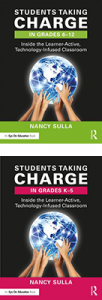 Deepen your knowledge of the power of problem-based learning in the classroom with a focus on implementation strategies. Design differentiated activity lists with multiple ways for students to learn, develop content facilitation grids and questions to support student-driven learning, and implement four types of formative assessments throughout the PBL unit. Note: Participants will apply course content to a previously created Problem-Based task and rubric.
Deepen your knowledge of the power of problem-based learning in the classroom with a focus on implementation strategies. Design differentiated activity lists with multiple ways for students to learn, develop content facilitation grids and questions to support student-driven learning, and implement four types of formative assessments throughout the PBL unit. Note: Participants will apply course content to a previously created Problem-Based task and rubric.
Syllabus
- Designing activity lists that offer students required activities, choice activities (offering more than one way to build a concept or skill), and optional activities (offering extension opportunities to those who are advanced) from a brainstormed scaffold for learning
- Developing facilitation grids, laying out skills and concepts to assess student learning as the teacher facilitates instruction.
- Designing facilitation questions to move students to higher-order thinking.
- Understanding the role of the Four Types of Formative Assessment to support progress monitoring and growth.
- Creating a transfer task as a venue for students to apply, or “transfer,” their learning from an authentic PBL unit to a new real-world context
Watch IDE Corp.’s YouTube video “What’s the difference between project-based learning and problem-based learning?“.
 This course will use your choice of Dr. Nancy Sulla’s books, Students Taking Charge In Grades K-5 or Students Taking Charge In Grades 6-12 as a resource. Only one is required. The assigned book must be purchased in advance. Access to MyQPortal is included for all participants while enrolled in the VLC. 25 contact hours.
This course will use your choice of Dr. Nancy Sulla’s books, Students Taking Charge In Grades K-5 or Students Taking Charge In Grades 6-12 as a resource. Only one is required. The assigned book must be purchased in advance. Access to MyQPortal is included for all participants while enrolled in the VLC. 25 contact hours.





 In this course, participants will leverage choice and technology to provide students with the ultimate differentiated learning environment. They will develop differentiated digital activity lists rooted in rigorous instruction that offer multiple ways to learn and apply content. Participants will explore autonomy, purpose, and mastery as motivators in all learning environments. They will design differentiated activity lists to put students in charge of their own learning, creating a structure that allows students to make decisions within a structured framework. Making informed decisions is an essential life skill that teachers can support with intentional classroom practices.
In this course, participants will leverage choice and technology to provide students with the ultimate differentiated learning environment. They will develop differentiated digital activity lists rooted in rigorous instruction that offer multiple ways to learn and apply content. Participants will explore autonomy, purpose, and mastery as motivators in all learning environments. They will design differentiated activity lists to put students in charge of their own learning, creating a structure that allows students to make decisions within a structured framework. Making informed decisions is an essential life skill that teachers can support with intentional classroom practices. Participants in this course will use Reinventing the Classroom Experience by Dr. Nancy Sulla as a resource. The assigned book must be
Participants in this course will use Reinventing the Classroom Experience by Dr. Nancy Sulla as a resource. The assigned book must be